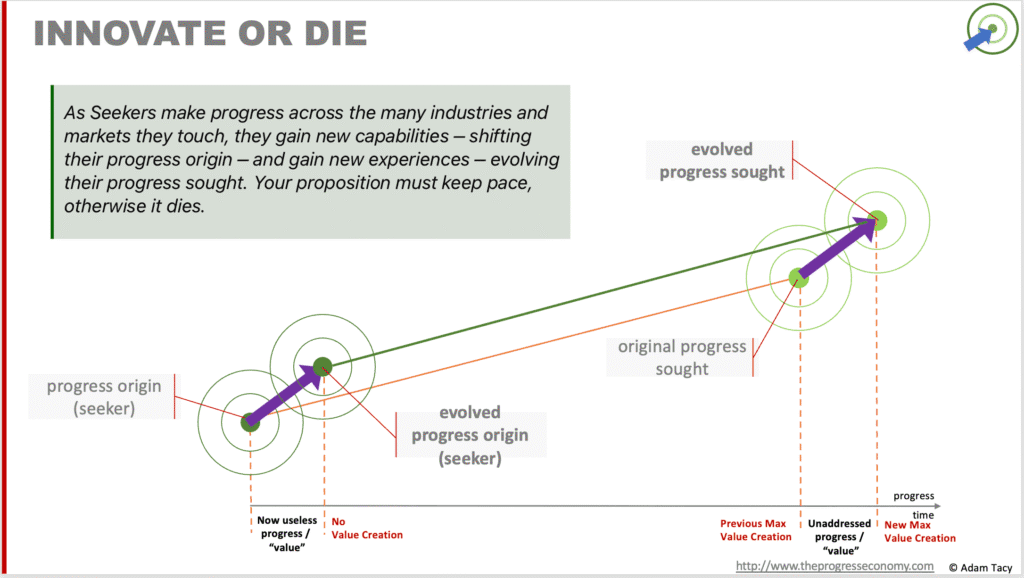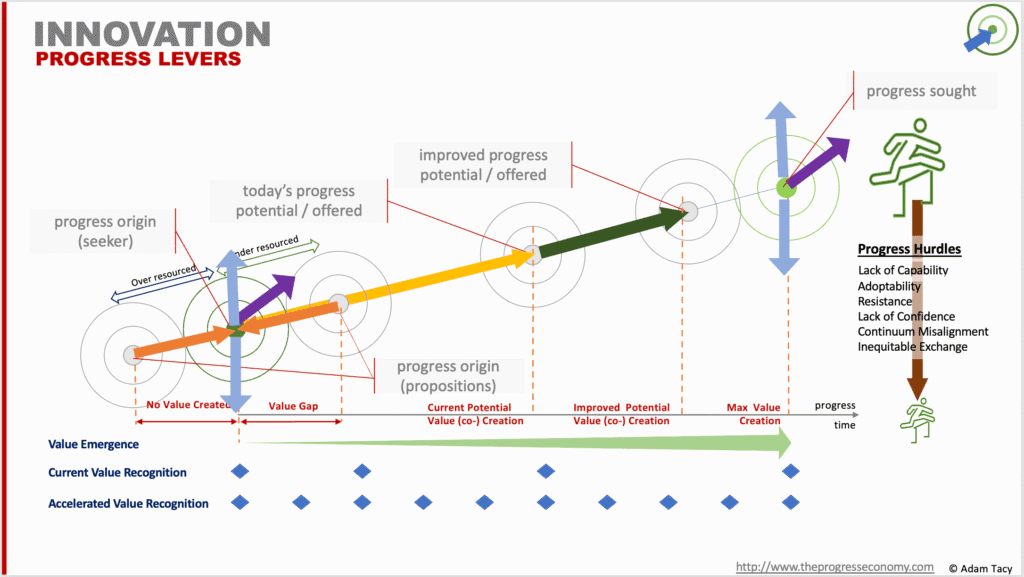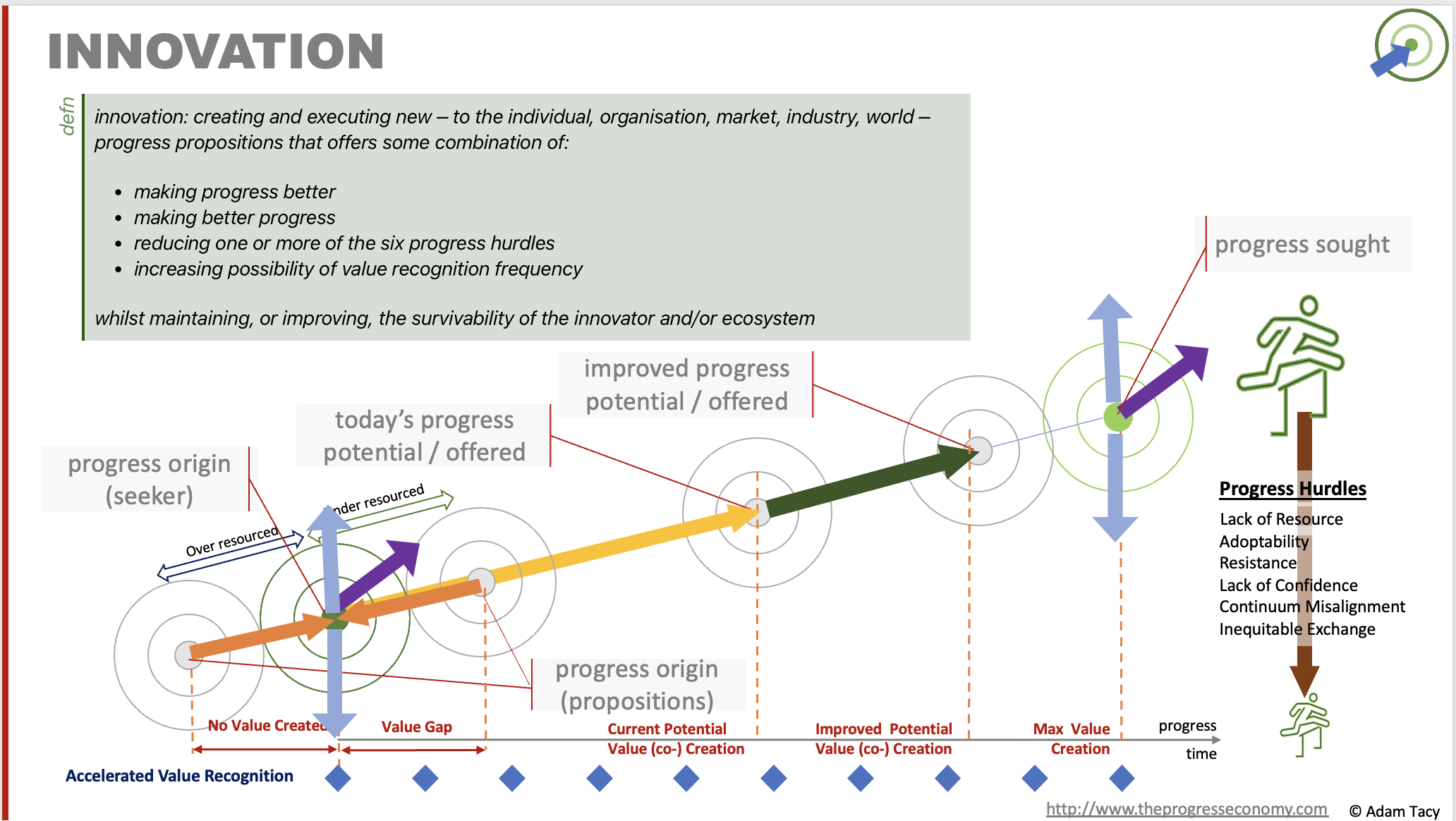Insights from the Progress Economy
If there’s a solution to the innovation problem, it lies in shifting our focus. We need to move away from the idea of adding value and towards the practice of enabling better progress – a perspective that is operational, measurable, and actionable.
Progress over value
The Progress Economy takes a crucial step forward: it recognises that value doesn’t exist independently — it emerges from progress. Value is a trailing indicator, the result of how people and organisations compare various states of progress. For example, their actual progress against their progress sought. In other words, value is a judgement; progress is the underlying movement that gives it meaning.
Progress, unlike value, can be clearly defined, observed, and influenced. It covers four core dimensions, the:
- more desired progress state a Seeker is trying to reach (progress sought), and where they are starting from (progress origin)
- progress journey they undertake — the set of activities, choices, and interactions that move them from origin to sought
- six progress hurdles that stand in their way – friction points that slow, distort, or block progress altogether
- frequency of value recognition – where emerged value becomes meaningful to the Seeker
Understanding these elements makes innovation more actionable. When we focus on enabling progress rather than adding value, two things happen:
- we operationalise innovation around measurable shifts in progress rather than abstract notions of value
- perceived value naturally increases when progress becomes value is a set of progress comparisons
And, naturally, innovation is reframed from “how do we add value?” to “how do we make (or help others make) better progress?”.
Why Progress Is Broader Than Value
Progress is a richer, more complete lens. It captures both the destination (the desired outcome or state change) and the journey (the sequence of actions and experiences required to get there). It reflects not just what people achieve, but what they overcome — the contexts, constraints, and trade-offs they navigate along the way.
This distinction becomes clear when you look at real examples:
- B2B: Cloud infrastructure providers did not simply offer cheaper servers – they enabled businesses to scale without owning data centers (aligning to progress sought), shifting capital expenditure to operating expenditure and reducing operational risk (lowering progress hurdles).
- Public sector: Digital identity programs don’t just improve “efficiency” – they help citizens progress through life events such as opening a bank account, accessing healthcare (aligning to progress sought) with less administrative friction (aligning to progress origin and reducing progress hurdles; though digital ids can increase the resistance progress hurdle if not managed).
- B2C: Streaming platforms did not just add “value” over DVDs – they removed friction from the progress of accessing and enjoying entertainment (aligned with progress sought)
When we see innovation through this lens, the focus changes from the artefacts we create to the states we enable. Progress becomes the unit of innovation; value becomes its outcome.
Let’s revisit the above challenges to innovation caused by a focus on value from a progress economy perspective
Why innovate? To get help making own progress
At its heart, innovation is the act of finding and applying new capabilities to make better progress. Either improving the way progress is already made, or enabling progress that was previously impossible.
In its simplest form, innovation helps us:
- existing progress better – a sharper knife makes cutting easier and more precise
- better progress than before – a food processor allows slicing, dicing, and blending at speed and scale that were once impractical.
In this way, both Seekers and Helpers can innovate. A Seeker might discover or create new capabilities, combine existing ones in inventive ways, or develop clever workarounds and shortcuts that make their own progress easier, faster, or more consistent. These “micro-innovations” often emerge invisibly in the real world. The teacher who designs her own grading spreadsheet, the nurse who rearranges equipment to improve patient flow, the manager who scripts a time-saving automation. Each represents progress made possible by ingenuity under constraint.
As the familiar Progress Economy story reminds us, Seekers often face a lack of capability – skills, knowledge, time. physical capabilities like strength, etc; or even the capability to innovate or execute innovations – when attempting progress.
Enter Progress Helpers.
Progress Helpers offer to supplement or extend Seekers’ capabilities, helping them move from a progress origin to a progress offered state. A Progress Helper could be an organisation, a platform, or even another individual – anyone offering capabilities that make it easier for a Seeker to achieve their desired progress.
Importantly, Progress Helpers are themselves Seekers of progress. They offer propositions in order to undertake service exchange for help making progress they seek that they lack capability to undertake.
This exchange can be direct — as in a traditional service transaction: you help me and I help you — or more likely indirect, mediated through what we might call transferable service credits. The most successful and universal form of such credits, of course, is money. It allows for the asynchronous, multi-party exchange of progress-making capability across time, scale, and context.
From this perspective, innovation becomes an act of mutual progress-making. A Helper’s incentive to innovate is clear. The Helper whose proposition best helps a Seeker progress – moving them closest to their progress sought from their progress origin, with the lowest progress hurdles and the earliest value recognition – will gain the greatest share of service exchange.
This reframes Peter Drucker’s classic observation that “the purpose of business is to create a customer.” In the Progress Economy, we restate it as:
The purpose of a Progress Helper is to gain help making progress relevant to themselves, through the maximum possible service exchange (direct or indirect; in number or magnitude). As such, the Helper has 3 – and only 3 – functions: marketing, innovation and execution
To achieve that, every organisation must perform three interdependent functions:
- Marketing — understanding which Seekers to help, and what progress they seek.
- Innovation — creating new or improved ways to enable that progress.
- Execution — delivering those capabilities effectively, reliably, and sustainably.
Why innovate? Innovate or die, explained
Peter Drucker’s famous warning of “innovate or die” has long felt intuitive. The Progress Economy helps us see why it holds true.
Seekers are not static. They are continually making progress attempts – not just in your market or industry, but across all aspects of their lives. In doing so, they gain new capabilities, experiences, and expectations. As a result, a Seeker’s progress origin (where they start from) and progress sought (the more desirable state they are trying to reach) are constantly evolving.
It looks like the following progress diagram.

Remember that value, in the progress economy, is a set of progress comparisons. Potential value, for example, includes the Seeker’s comparisons of progress sought and progress offered, as well as their origin compared to the proposition’s origin. As the Seeker’s states evolve, the proposition is seen as helping make progress less and less.
When that happens, service exchange declines. If left unchecked, your proposition’s relevance fades away. The Helper needs to evolve their proposition. That is, they need to innovate, or die.
We see this pattern everywhere. What once felt like breakthrough progress — the high street bank branch, the compact disc, the business-class lounge — becomes unremarkable once Seekers learn new ways to make better progress. Challenger banks, streaming services, and shared workspaces didn’t just offer cheaper or more convenient options; they matched the new shape of Seeker progress more closely.
So Drucker’s phrase isn’t a threat; it’s a natural law. The Progress Economy explains it not as a matter of will or competition, but as a matter of alignment. Innovation is the act of staying in sync with, or ahead of, the evolving progress of those you serve.
Restructuring below here
Removing blindspots
Thinking in terms of progress minimises the blind spots found in our traditional value model.
Prioritising consistency over customisation – missing value before exchange
Customisation is the priority over consistency. Propositions should align closely to Seeker’s origin and progress sought to increase judgements of potential progress (value). Something that is attempted either during the sales or innovation processes (we’ll come back to this shortly).
Chasing the next transaction – missing post-exchange value
Valuing new exchanges over circular thinking – missing value across the exchange
Our focus on progress sought and progress origins should minimise missing post- and across-exchange “value”, since we take a holistic view of what the Seeker is trying to achieve.
Sadly, such understanding likely explains the challenges to sustainability by identifying it is progress that is not sufficiently sought. Hence the need for externalities to step in and enhance progress sought with those needs. For example the aluminium can and plastic bottle recycling requirements in Sweden and other countries.
Elevating goods over services – narrowing the solution space
We also remove the unhelpful goods vs services debate when we focus on progress. In fact, we see everything as a service (singular) – application of skills and competence to benefit oneself or others. Sometimes that service can be frozen into a goods enabling it to be distributed in time and location.
Consider music. You can listen to a band performing live, which is a clear act of service. That same performance can be captured digitally and stored on a CD or embedded into a vinyl record. In doing so, the service has been “frozen” allowing for it to be transported in time and space. When you later press play, the original service is “unfrozen”.
Falling into marketing myopia –
Different propositions offering the same progress will have different combinations of employees, goods and systems in their resource mix; they are exchangeable. This helps address marketing myopia – we are freed to hunt the best resource mix to make that quarter-inch hole rather than get trapped into innovating new features on a drill.
Favouring simple exchange over more innovative business models
Assuming providers define value
And
Redefining Innovation
innovation is reframed from “how do we add value?” to “how do we make (or help others make) better progress?”. More specifically, we can define it as a combination of actionable levers:

innovation: creating and executing new – to the individual, organisation, market, industry, world – progress propositions that offers some combination of:
- making today’s progress better
- making better progress than today, towards progress sought
- reducing one or more of the six progress hurdles
- increasing possibility of value recognition frequency
whilst maintaining, or improving, the survivability of the innovator and/or ecosystem
This definition deserves a deeper dive – something we do in this article.
Innovation and Sales: two sides of the same coin
A comparison
| Domain | Example |
|---|---|
| SaaS Provider | Value: A SaaS provider that invests heavily in adding AI-driven dashboards, predictive analytics, and real-time alerts to its platform – features the internal team is proud of, and which marketing hails as “adding value.” Progress: Yet customer usage data shows these features are rarely used. Why? Because customers’ real progress sought was simplifying decision-making, not adding another layer of data. The innovation added complexity rather than enabling progress. |
| Logistics | Progress. Focused on the same core customer outcome – faster decision-making – and redesigned its booking platform to auto-recommend the most cost-effective routes based on constraints and historical patterns. Customers reported not just higher satisfaction, but faster turnaround times and lower total shipping costs. Progress, in the Seeker’s terms, was unmistakably made. |
| Manufacturing | A component supplier might introduce a new alloy with 15% greater tensile strength, believing it “adds value.” But their customers (OEMs designing for cost efficiency) may not need the additional strength and instead see the new alloy as unnecessary expense and redesign effort. By contrast, a competitor that focuses on reducing lead times and minimising stockouts might create more meaningful progress for the OEM – keeping production lines running and reducing working capital tied up in inventory. |
| Professional Services | A consulting firm might add more research deliverables, more slides, and more depth to its recommendations; believing that a thicker report “adds value.” Yet the client’s progress sought is clarity and confidence in decision-making under pressure. A firm that innovates its delivery model, for instance by using digital collaboration tools to co-create solutions in real time and iterating with client teams, often drives far more impact. The decision is made faster, adoption is smoother, and results appear sooner. |
Why this matters
We face both an innovation and a growth problem. McKinsey report that 94% of executives are dissatisfied with their innovation initiatives. The IMF warns that the 2020s risk becoming a period of weak economic performance — what they call the tepid twenties.
The root of the problem lies in how we define innovation. For too long, it has been framed as “creating” or “adding value” – a vague, slippery concept that is difficult to translate into consistent action. By adopting a progress-first perspective, we can redefine innovation around something more concrete and actionable: improving progress. From this sharper definition, a set of levers naturally emerges. These levers are tools that allow us to systematically improve both innovation and sales.
Our need to innovate is propelled by two fundamental forces:
- Seekers’ relentless drive to complete their progress journey. From progress origin to progress sought, that motivation never fades.
- Seekers’ ever-evolving expectations. With every new progress attempt — whether direct experience or observation across categories, industries, or markets — capabilities improve, expectations rise, and origins and sought states shift.
For Progress Helpers, Drucker’s warning of innovate or die is not an overstatement. It is operating reality. If you do not help Seekers make their evolving progress, someone else will.
The practical question for leaders is therefore simple but profound: Which of the progress levers are you actively choosing to pull to increase your innovation success?
Or, as Christensen urged: stop “competing against luck”.

Let’s progress together through discussion…